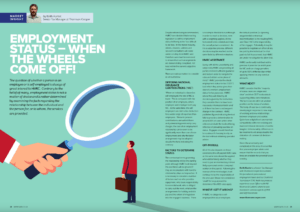We are delighted to work in partnership with the Scottish Motor Trade Association (SMTA), providing articles for their fantastic Auto Insight magazine.
In the 11th edition, Senior Tax Manager Keith Hunter examines the difficulty businesses can encounter when determining if a worker is an employee or is self-employed.
You’ll find the complete article on pages 22 & 23.
The question of whether a person is an employee or is self-employed is always of great interest to HMRC. Contrary to the belief of many, employment status is not a matter of choice and is rather determined by examining the facts regarding the relationship between the individual and the person for, or to whom, the services are provided.
Despite reform being recommended, HMRC have decided that enacting legislation to define employment status fell firmly in the ‘too difficult to do’ box. In the motor industry, drivers, cleaners, valeters and (as ever) consultants will come under scrutiny from HMRC and therefore care must be exercised to ensure that such arrangements are demonstrably compliant, not least within the current subjective framework.
There are various matters to consider as set out below:
Differing National Insurance Contributions (‘NIC’)
Where an individual is classed as self-employed, the rate of NIC is lower. This is compared with the position of an employee, where employee and employer both pay NIC. At the same time, the self-employed can claim a tax deduction for a wider range of expenses than employees. Throw in pension contributions, annual/sick leave and potential Apprenticeship Levy charges, the cost of an employment relationship can be seen to be significantly more than one of non-employment and why the latter arrangement may be adopted despite the facts indicating the contrary.
Factors to determine status
The contractual terms governing the relationship will be the starting point although HMRC look beyond this and these will be ignored if they are inconsistent with how the relationship plays out in practice. It is necessary to consider a number of factors such as who provides equipment, who bears responsibility for remedial work, who is obliged to carry out the work, what are the arrangements for holiday and sick pay and the extent of integration into the engager’s business. There is no simple checklist to run through in order to reach a decision, even with a weighting applied. All the facts need to be collated and then the overall picture considered. As it is a subjective process, different decisions may be reached on the same facts by different evaluators.
HMRC assistance
Surely with all this uncertainty and subjectivity HMRC are providing all parties involved sufficient guidance and tools in order to navigate the rules and obtain some piece of mind? HMRC provide the check employment status for tax (‘CEST’) tool which they advise gives their view of a worker’s employment status for tax purposes. HMRC advise they will stand by all decisions given by the tool unless they consider there to have been inaccurate information fed in and/or if there has been a subsequent change in the contract. HMRC published figures indicating the tool fails to provide a determination in around 20% of cases whilst other criticisms include the tool not being reflective of prevailing case law on status. Engagers should therefore be cautious if choosing to rely on the tool without obtaining specialist advice.
Off-payroll
All of this also impacts on those covered by the off-payroll (IR35) rules as the same tests should be applied when determining whether they need to put an intermediary’s (most likely a personal service company) worker on the payroll. Following the reversal of the mini-budget, it will continue to be the responsibility of the end-user (those not considered ‘small’ for tax purposes) to determine if the IR35 rules apply.
What if I get it wrong?
If HMRC re-categorise a self-employed hire as an employee, the default position (i.e. ignoring any potential contractual indemnification) is the resulting PAYE and Class 1 NIC is the responsibility of the engager. Potentially, it may be possible to negotiate an offset of any tax paid by the individual (i.e. that paid via Self-Assessment), but HMRC are under no obligation to allow that.
HMRC can broadly look back at the previous 4 years for tax and 6 years for NIC and can charge penalties of up to 100% of the tax due whilst applying interest on any overdue amounts.
What next?
HMRC consider that the “majority of status cases are simple and clear” and their CEST tool assists in supporting status determinations. The fact is we are still in an unclear position on the status of workers. The body of case law is continually developing in response to new ways of working and new relationships between employer and worker. Quite how a digital tool can maintain compatibility with ever evolving and nuanced tribunal decisions is hard to imagine. Unfortunately, differences in tax treatments will always lead to the distortion of commercial decision-making.
Given the uncertainty and complexity in this area, it is essential that you seek proper advice and ensure that the records that you keep are available for potential future scrutiny.
Keith Hunter specialises in personal and employment taxes and is a Chartered Tax Advisor (CTA). He has previous experience as an Officer with HM Revenue & Customs where he was involved in various aspects of PAYE and Self-Assessment. For more information on this subject, contact us at info@thomsoncooper.com.

